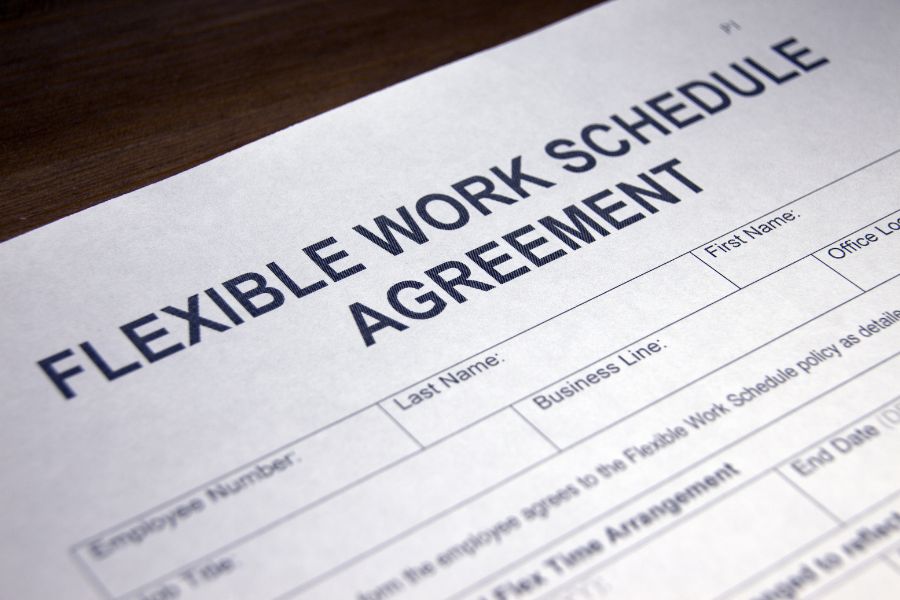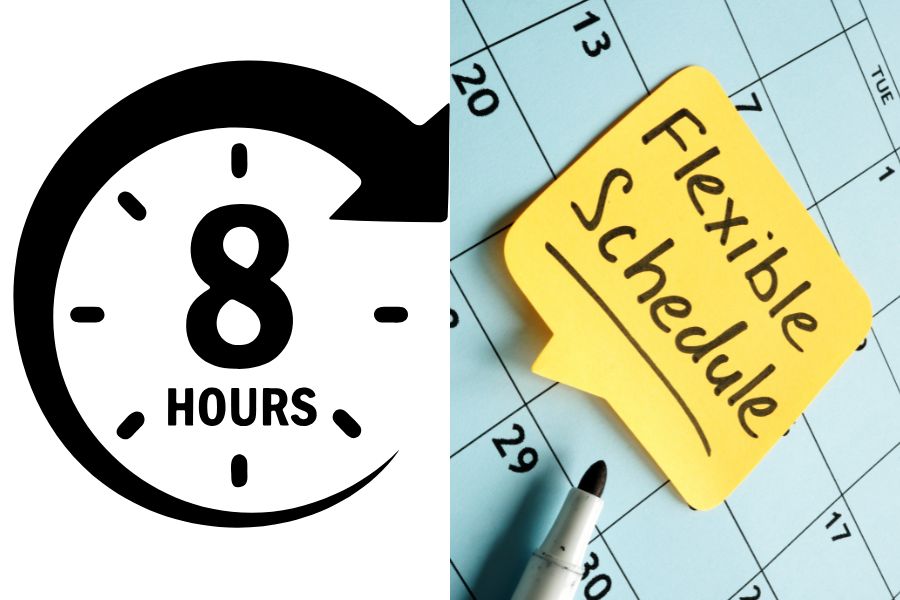In the evolving landscape of work, the debate between flexible hours vs fixed hours has become increasingly relevant.
As remote work and hybrid models gain traction, employees and employers alike are reevaluating traditional work structures to find a balance that promotes productivity, satisfaction, and well-being.
Flexible hours allow employees to choose when they work, while fixed hours require adherence to a set schedule. Both approaches have their merits and drawbacks, particularly when it comes to work-life balance.
This article will compare flexible hours and fixed hours, examining their impact on productivity, mental health, and overall work-life harmony.
By the end, you’ll have a clearer understanding of which approach might be better suited for your lifestyle and career.
1. The Importance of Work-Life Balance in Modern Work Culture
Before diving into the comparison, it’s important to understand why work-life balance matters. Work-life balance refers to the equilibrium between professional responsibilities and personal life.
A healthy balance can lead to:
- Improved Mental Health: Reduced stress, anxiety, and burnout.
- Higher Productivity: Increased focus and efficiency during work hours.
- Greater Job Satisfaction: Enhanced morale and loyalty to the organization.
- Stronger Personal Relationships: More time and energy for family, friends, and hobbies.
Both flexible and fixed hours aim to support work-life balance, but they do so in different ways. Let’s explore each approach in detail.
2. The Case for Flexible Hours

Flexible hours, also known as flextime, allow employees to choose their start and end times, as long as they complete their required hours and meet deadlines. This approach has gained popularity for its ability to accommodate diverse lifestyles and personal needs.
2.1 Personalized Scheduling
Flexible hours empower employees to design their workday around their most productive times and personal commitments.
- Peak Productivity: Work during hours when you’re most alert and focused, whether you’re an early bird or a night owl.
- Personal Commitments: Schedule work around childcare, errands, or other responsibilities.
2.2 Improved Work-Life Integration
Flexible hours make it easier to blend work with personal life, reducing the stress of rigid schedules.
- Family Time: Attend school events, doctor’s appointments, or family gatherings without taking time off.
- Self-Care: Incorporate exercise, hobbies, or relaxation into your daily routine.
2.3 Reduced Commute Stress
Flexible hours can help employees avoid peak commute times, saving time and reducing stress.
- Off-Peak Travel: Choose less crowded times for commuting, whether to the office or running errands.
- Remote Work Flexibility: Combine flexible hours with remote work for even greater convenience.
2.4 Enhanced Job Satisfaction
Employees with flexible schedules often report higher job satisfaction and loyalty to their employers.
- Autonomy: Greater control over your schedule fosters a sense of trust and empowerment.
- Work-Life Harmony: Ability to balance work and personal life leads to greater overall happiness.
3. The Challenges of Flexible Hours
While flexible hours offer many benefits, they also come with challenges that can impact work-life balance and productivity.
3.1 Blurred Boundaries
Without a clear separation between work and personal time, employees may struggle to “switch off.”
- Overwork: The flexibility to work anytime can lead to longer hours and difficulty disconnecting.
- Guilt: Employees may feel pressured to be constantly available, even during personal time.
3.2 Coordination Challenges
Flexible hours can make it harder to schedule meetings and collaborate with colleagues.
- Time Zone Differences: For remote teams, coordinating across time zones can be complex.
- Availability Gaps: Team members may have overlapping work hours, delaying communication and decision-making.
3.3 Self-Discipline Requirements
Flexible hours require strong time management and self-discipline to stay productive.
- Procrastination: Without a fixed schedule, it’s easier to put off tasks or lose focus.
- Distractions: Working from home or during non-traditional hours can lead to interruptions.
3.4 Potential for Isolation
Employees with flexible hours may miss out on the social interactions and camaraderie of a traditional office environment.
- Lack of Connection: Fewer opportunities for casual conversations and team bonding.
- Remote Work Challenges: Combining flexible hours with remote work can exacerbate feelings of isolation.
4. The Case for Fixed Hours

Fixed hours require employees to work a set schedule, typically during standard business hours. This traditional approach provides structure and predictability, which can be beneficial for both employees and employers.
4.1 Clear Boundaries
Fixed hours create a clear separation between work and personal life, making it easier to disconnect.
- Work-Life Balance: Defined work hours help employees mentally “clock out” at the end of the day.
- Routine: A consistent schedule fosters discipline and reduces decision fatigue.
4.2 Enhanced Collaboration
Fixed hours make it easier to schedule meetings and collaborate with colleagues.
- Synchronized Schedules: Team members are available at the same time, facilitating real-time communication.
- Team Cohesion: Shared work hours promote camaraderie and a sense of belonging.
4.3 Predictability
Fixed hours provide a predictable routine, which can reduce stress and improve planning.
- Structured Day: Knowing your work hours in advance helps you plan personal activities and commitments.
- Consistency: A regular schedule can improve sleep patterns and overall well-being.
4.4 Employer Oversight
Fixed hours allow employers to monitor productivity and provide support more effectively.
- Accountability: Clear expectations for work hours ensure employees are available when needed.
- Support: Managers can provide guidance and feedback in real-time.
5. The Challenges of Fixed Hours
While fixed hours offer structure and predictability, they also come with drawbacks that can impact work-life balance and flexibility.
5.1 Rigidity
Fixed hours can feel restrictive, especially for employees with personal commitments or non-traditional lifestyles.
- Lack of Flexibility: Difficulty accommodating childcare, appointments, or other responsibilities.
- Commute Stress: Fixed hours often align with peak commute times, increasing stress and travel time.
5.2 Reduced Autonomy
Employees with fixed schedules may feel less control over their workday, leading to lower job satisfaction.
- Limited Freedom: Less ability to tailor work hours to personal preferences or productivity peaks.
- Micromanagement: Fixed hours can feel overly prescriptive, reducing trust and empowerment.
5.3 Burnout Risk
Rigid schedules can lead to burnout if employees feel overworked or unable to recharge.
- Lack of Breaks: Fixed hours may not allow for sufficient breaks or downtime during the day.
- Work-Life Conflict: Difficulty balancing work demands with personal life can increase stress.
5.4 Limited Adaptability
Fixed hours may not accommodate the diverse needs of a modern workforce, such as remote work or global teams.
- Time Zone Challenges: For remote teams, fixed hours may not align with employees in different time zones.
- Changing Needs: Fixed schedules may not adapt well to evolving personal or professional demands.
6. Key Factors to Consider
When choosing between flexible hours and fixed hours, consider the following factors to determine which approach is better for your work-life balance.
6.1 Personal Preferences
Evaluate your personal preferences and how they align with each approach.
- Flexibility Seekers: If you value autonomy and the ability to customize your schedule, flexible hours may be ideal.
- Structure Seekers: If you thrive on routine and predictability, fixed hours may be a better fit.
6.2 Job Requirements
Consider the nature of your job and how it aligns with each approach.
- Collaborative Roles: Fixed hours may be better for roles requiring frequent teamwork and real-time communication.
- Independent Roles: Flexible hours may suit roles that allow for independent work and self-directed tasks.
6.3 Personal Commitments
Think about your personal commitments and how they impact your schedule.
- Family Responsibilities: Flexible hours can help you balance work with childcare or other family needs.
- Health and Wellness: Fixed hours may provide a consistent routine that supports mental and physical health.
6.4 Employer Policies
Assess your employer’s policies and culture regarding work hours.
- Support for Flexibility: Some employers may offer flexible hours as part of their benefits package.
- Cultural Expectations: In some industries or organizations, fixed hours may be the norm.
7. Key Takeaways and Recommendations
Deciding between flexible hours and fixed hours depends on your specific needs, preferences, and job requirements. Here are some key takeaways and recommendations to help you choose.
- Choose Flexible Hours If: You value autonomy, have personal commitments, or work in a role that allows for independent work.
- Choose Fixed Hours If: You thrive on routine, work in a collaborative role, or prefer clear boundaries between work and personal life.
- Consider a Hybrid Approach: Combine flexible hours for certain tasks or days with fixed hours for meetings and collaboration.
Conclusion
The choice between flexible hours vs fixed hours ultimately depends on your personal preferences, job requirements, and lifestyle.
Flexible hours offer autonomy and the ability to customize your schedule, making them ideal for those with personal commitments or independent roles. Fixed hours provide structure and predictability, which can enhance collaboration and work-life balance for those who thrive on routine.
By carefully evaluating your priorities and experimenting with both approaches, you can find the work schedule that best supports your productivity, well-being, and overall work-life harmony.
As the future of work continues to evolve, having the right balance between flexibility and structure will be key to thriving in a dynamic and ever-changing work environment.

1 thought on “Flexible Hours vs Fixed Hours: Which is Better for Work-Life Balance?”